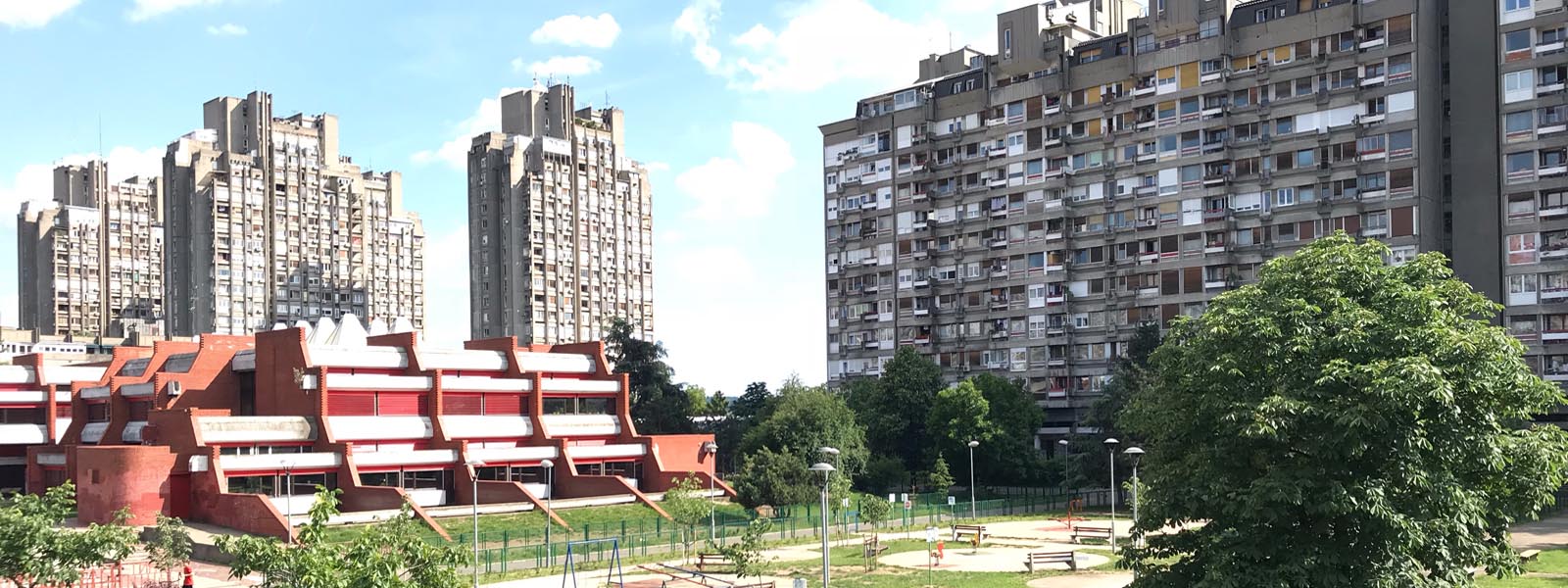 |
Donagh HorganFormer PhD student, Department of Architecture
|
A humane Brutalism - Yugoslavia’s ambitions of Housing for All
Donagh Horgan was a doctoral student at the Department of Architecture, University of Strathclyde. Supervisor: Professor Branka Dimitrijevic
While conducting field research in ex-Yugoslavia, as part of an Erasmus+ international placement with the University of Belgrade, the question of “What could have been?” is one that persistently lingers. With all the fanfare of the end of the Cold War, in the final throes of the binary battle between eastern socialism against western capitalism, it is often forgotten that there was a ‘third way’. The market socialism espoused by the Socialist Federal Republic of Yugoslavia (SFRY) sat somewhat ambiguously between the two economic poles - a way to maintain an open and business-friendly society through collaboration among collective enterprises and small private businesses. During the mid-twentieth century the Yugoslav economic system - and accompanying collaborative foreign policy through the Non-Aligned Movement (NAM) - influenced a number of post-colonial and developing world countries in the pursuit of an equitable modernisation (Stierli and Kulić, 2018). NAM forged relationships between Yugoslavia and countries across the Middle East, Africa, Asia and Latin America. In turn the construction industry - manpower, design and innovation – became SFRY’s biggest economic export until its demise. An article on these missionary builders of Yugoslavia features among the catalogue in ‘Towards a Concrete Utopia: Architecture in Yugoslavia, 1948–1980’, an acclaimed exhibition that opened last year in New York’s MoMA (Stierli and Kulić, 2018).
Betonski spavači (Concrete dreamers) - the concrete foundations of a socialist housing system
It’s a cliché to say that Belgrade is a city at the crossroads. For centuries the confluence of the Sava and the Danube buttressed the edge of both the Ottoman and Habsburg empires. The sandy space in between these outposts was eventually inhabited, becoming New Belgrade. Conceived as an exercise in statecraft and a solution to the city’s chronic housing shortage, New Belgrade was to be the administrative centre of the federal socialist republic. Flexible, easy to build and replicate, complex prefabricated solutions are the norm, standing in stark contrast to banal, repetitive boxes of their Soviet counterpart. Apartment typologies are to a western standard, yet provide subtle cues as to the socialist context of collective living. The fact that the apartments of New Belgrade continue to command some of the highest market resale values is evidence that there must be an admiration of the quality of buildings. New Belgrade and its regional counterparts throughout Yugoslavia sought to provide new neighbourhoods following modernist principles of Le Corbusier, contemporaries at CIAM and the Athens charter. Housing typologies and designs were as much influenced by socialist thinking in neighbouring countries as the architecture of the welfare states of Northern Europe (Stierli and Kulić, 2018). Yet away from aesthetics, what can this architecture tell us about building resilience for communities elsewhere, and are there any models that can inform contemporary approaches to provide a more equitable economic, social and built environment?
All through the era of the Cold War, Yugoslavia continued to forge its own path and influence thinking on the international stage, in forms of both policy and architecture. Self-management meant that decision-making was devolved to the workers, who through union and assembly would resource the public service, and realise the political aims of the federation of unified inter-ethnic states (Unkovski-Korica, 2015). In an essay in the MoMa publication, Maroje Mrduljaš, describes how the “project of self-management attributed a great deal of agency to architects and urban planners” (Stierli and Kulić, 2018). State enterprises were required to provide housing for their workers and draw up detailed lists of specifications for individual families. Pursuing a policy of ‘housing for all’, the construction industry grew into a sizeable and complex ecosystem of large contractors, teams of architects and offices for development and innovation. In practice however, self-management only truly occurred at an institutional level, without widespread stakeholder participation at the citizen level outside of the ‘mjesna zajednica’, voluntary assembly of local citizens interested in improving management of their local area.
The high-quality apartment – the most advanced mass product of Yugoslav self-management
Prototypes for infrastructure and housing refined in the modernisation of Yugoslavia were exported internationally alongside knowledge and services in the decades that led up until the end of the last century. The companies that grew to solve the country’s demand for dignified housing and a decent quality of life, became providers of housing and infrastructure solutions on an immense scale, still operating globally. Before the Gulf War there were tens of thousands of Yugoslavs working on projects in Baghdad (Stierli and Kulić, 2018). The ‘high-quality apartment’ is considered by Mrduljaš, to be the “most advanced mass product of Yugoslav self-management” (Stierli and Kulić, 2018). However, the project of providing housing for all was never complete as supply - slow and costly - never could meet with demand (Archer, 2018). Although the system of allocation was not always efficient, social mixture in housing was common. Many low-level workers - failing to reap any rewards in the large-scale provision of housing - began to build independent informal housing following traditional ways, on the periphery of big towns and cities. Early rising, short working days in Yugoslavia meant that workers could form bands of house builders - in close familiar or neighbourhood groups – self-managing a system of self-building.
The anti-austerity protests that took hold across Yugoslavia in the seventies and eighties took issue in particular with the lack of adequate housing for all, and the perceived inequalities produced by the system (Krstić, 2018). However spurious, some commentators see correlations between a failure to address the housing crisis, with the fragmentation that preceded the eventual breakup of Yugoslavia (Krstić, 2018). Belgrade is still reeling from the upheavals of the nineties, and its urban fabric bears deep scars - notwithstanding the fissures left by the NATO bombing of 1999. Absented planning policy in the wake of Yugoslavia collapse saw the earmarked but ultimately unrealised civic spaces of New Belgrade infilled with aesthetically questionable commercial developments. The move to market capitalism has added new construction in parts of New Belgrade while cutting away at common green spaces and parks. A set of unpopular planning decisions have seen the rise of spatial activism from groups such as ‘Ne da(vi)mo Beograd’ (Do not strangle and give away Belgrade) [https://nedavimobeograd.rs/]. A lamentable statistic that has seen Belgrade’s socialised housing stock fall to about 0.8% from a number of almost 80% under socialism (Krstic, 2017) has spurned on several non-governmental organisations such as ‘Ko Gradi Grad’ (Who Builds a City) [http://www.kogradigrad.org/] and ‘Za krov nad Glavom’ (For a Roof over a Head)[ http://zakrovnadglavom.org/] to take action.
Housing requires an investment in people, in the future, in believing that alternatives are possible. In ‘Belgrade - Formal/Informal - A Study on Urban Transformation’ (Meili et al, 2012), Milica Topalovic explains self-management as a form of “state ownership transformed to social ownership”. If housing was considered to transmit a social value - in the way that Mariana Mazzucato (2018) writes about social value - as opposed to being treated as a mere commodity, the nature of social ownership could be radically interpreted according to this line of thought. Given the global nature of our current housing crisis, a shared challenge for communities across the world - Belgrade could do worse than look again at some of the ideas of the past, and at how they could be recombined, reinterpreted or reimagined to encourage bottom-up self-build supported by models for collective self-governance.
References
Archer, R., 2018. The moral economy of home construction in late socialist Yugoslavia. History and anthropology, 29(2), pp.141-162.
Krstić, I., 2018. The Housing Policies in Yugoslavia. In: Knežević, V. and Miletić, M. (Eds), 2018. We Have Built Cities for You: On the Contradictions of Yugoslav Socialism. Belgrade: Production Centre for Cultural Decontamination.
Krstić, I., 2017. Housing Policy in Serbia – From Privatization to Eviction. Available online: http://www.masina.rs/eng/housing-policy-serbia-privatization-eviction/
Mazzucato, M., 2018. The value of everything: Making and taking in the global economy. UK: Allen Lane.
Meili, M., Diener, R., Topalović, M. and Muller Inderbitzin, C. (Eds), 2012. Belgrade. Formal/informal: A research on urban transformation. Zürich: Scheidegger&Spiess.
Stierli, M. and Kulić, V., 2018. Toward a Concrete Utopia: Architecture in Yugoslavia, 1948–1980. New York: The Museum of Modern Art.
Unkovski-Korica, V., 2015. Self-management, development and debt: the rise and fall of the 'Yugoslav experiment'. In: Štiks, I. and Horvat, S. (eds.) Welcome to the Desert of Post-Socialism: Radical Politics After Yugoslavia. Verso: London.
Photos © Donagh Horgan
Donagh is a doctoral student at the Department of Architecture part funded by the BRE. He is nearing completion of a global study entitled ‘Social innovation Systems for Building Resilient Communities’, comprising a set of international case. He currently works as a project manager with the Institute for Future Cities, and is a founding member of the recently established Socially Progressive Innovation and Entrepreneurship (SPIE) research cluster.
